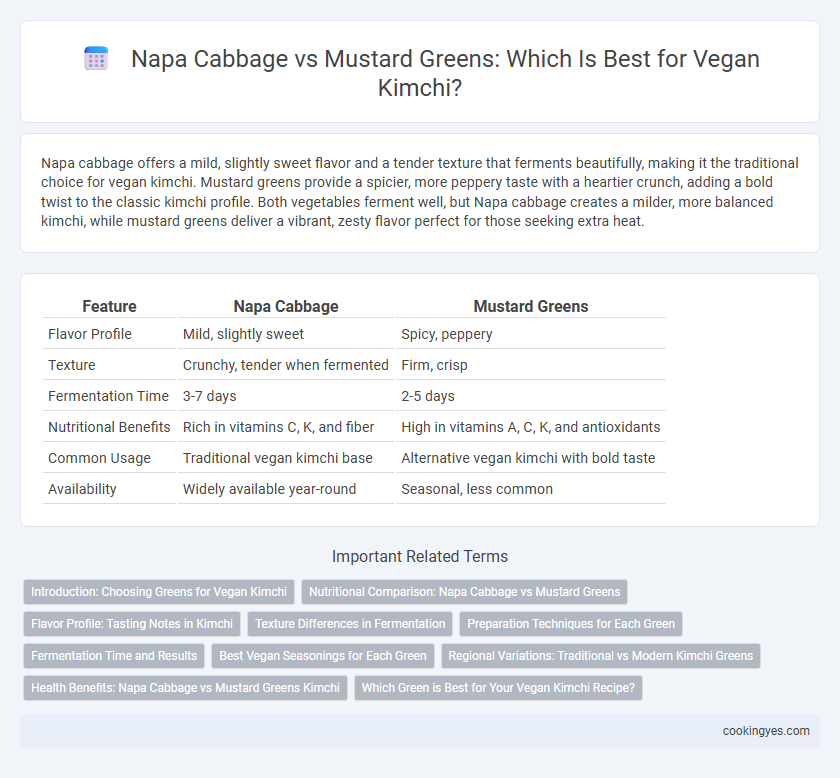Napa cabbage offers a mild, slightly sweet flavor and a tender texture that ferments beautifully, making it the traditional choice for vegan kimchi. Mustard greens provide a spicier, more peppery taste with a heartier crunch, adding a bold twist to the classic kimchi profile. Both vegetables ferment well, but Napa cabbage creates a milder, more balanced kimchi, while mustard greens deliver a vibrant, zesty flavor perfect for those seeking extra heat.
Table of Comparison
| Feature | Napa Cabbage | Mustard Greens |
|---|---|---|
| Flavor Profile | Mild, slightly sweet | Spicy, peppery |
| Texture | Crunchy, tender when fermented | Firm, crisp |
| Fermentation Time | 3-7 days | 2-5 days |
| Nutritional Benefits | Rich in vitamins C, K, and fiber | High in vitamins A, C, K, and antioxidants |
| Common Usage | Traditional vegan kimchi base | Alternative vegan kimchi with bold taste |
| Availability | Widely available year-round | Seasonal, less common |
Introduction: Choosing Greens for Vegan Kimchi
Napa cabbage and mustard greens are the most popular greens used in vegan kimchi, each offering distinct textures and flavors. Napa cabbage provides a crisp, tender bite with a mild sweetness, making it a classic choice for traditional kimchi recipes. Mustard greens introduce a peppery, slightly bitter note that enhances the complexity and boldness of vegan kimchi varieties.
Nutritional Comparison: Napa Cabbage vs Mustard Greens
Napa cabbage and mustard greens both serve as excellent bases for vegan kimchi, offering distinct nutritional profiles that impact health benefits. Napa cabbage is low in calories and rich in vitamin C, potassium, and fiber, supporting immune function and digestive health. Mustard greens provide a higher concentration of vitamins A, K, and calcium, enhancing antioxidant defenses and bone strength while contributing a slightly spicier flavor to the kimchi.
Flavor Profile: Tasting Notes in Kimchi
Napa cabbage offers a mild, slightly sweet flavor with a tender texture that balances the spicy, garlicky notes in vegan kimchi, enhancing its umami depth. Mustard greens contribute a sharper, peppery bite and a more robust, earthy taste, intensifying the kimchi's pungency and adding complex heat. Choosing between Napa cabbage and mustard greens significantly affects the flavor profile, with Napa lending subtle sweetness and mustard greens delivering bold spice and bitterness.
Texture Differences in Fermentation
Napa cabbage offers a tender yet crisp texture that softens uniformly during fermentation, creating a balanced mouthfeel ideal for traditional vegan kimchi. Mustard greens provide a more robust, fibrous texture with a slightly peppery bite, maintaining a firmer crunch throughout the fermentation process. The choice between these greens significantly influences the overall sensory experience, with napa cabbage delivering a smoother ferment and mustard greens adding complexity and resilience in texture.
Preparation Techniques for Each Green
Napa cabbage requires thorough salting and soaking to draw out moisture, ensuring a tender texture and crisp bite in vegan kimchi. Mustard greens need shorter salting times due to their delicate leaves but benefit from gentle massaging to release natural bitterness and enhance fermentation. Both preparation techniques optimize the greens' flavors and textures, vital for achieving authentic vegan kimchi taste.
Fermentation Time and Results
Napa cabbage ferments within 5 to 7 days, producing a tender texture and a balanced, mildly sour flavor ideal for traditional vegan kimchi. Mustard greens require a shorter fermentation time, typically 3 to 5 days, resulting in a crisper bite and a more pungent, spicy taste that intensifies quickly. The choice between Napa cabbage and mustard greens significantly influences the fermentation duration and flavor profile, offering distinct textures and acidity levels for vegan kimchi variations.
Best Vegan Seasonings for Each Green
Napa cabbage kimchi pairs well with traditional vegan seasonings such as garlic, ginger, red chili flakes, and fermented soy sauce to achieve its classic umami flavor. Mustard greens require bolder seasonings like toasted sesame oil, ground mustard seeds, and a touch of miso paste to complement their peppery bite. The choice of seasonings enhances the unique textures and flavors of each green while maintaining authentic vegan kimchi taste profiles.
Regional Variations: Traditional vs Modern Kimchi Greens
Napa cabbage remains the quintessential vegetable for traditional kimchi, particularly in Korean regions like Seoul and Jeolla, where its mild flavor and crisp texture create the classic tangy fermentation profile. Mustard greens are favored in southern coastal areas such as Jeju and Busan, where their spicy, peppery notes produce a bolder, more pungent kimchi variation reflecting local tastes. Modern vegan kimchi recipes increasingly blend Napa cabbage with mustard greens to balance sweetness and heat, showcasing evolving regional adaptations and contemporary palates.
Health Benefits: Napa Cabbage vs Mustard Greens Kimchi
Napa cabbage kimchi is rich in vitamins C and K, antioxidants, and dietary fiber, promoting digestion and boosting immune function. Mustard greens kimchi contains higher levels of calcium, vitamin A, and glucosinolates, which support bone health and possess cancer-fighting properties. Both fermented vegetables offer probiotics essential for gut health, but mustard greens provide a more potent anti-inflammatory effect.
Which Green is Best for Your Vegan Kimchi Recipe?
Napa cabbage delivers a mild, crunchy texture and absorbs spices well, making it the most popular choice for vegan kimchi. Mustard greens add a peppery, bold flavor and a firmer bite, ideal for those seeking a more robust and slightly bitter profile. Choosing between Napa cabbage and mustard greens depends on whether you prefer the traditional softness of vegan kimchi or a spicier, textured variation.
Napa Cabbage vs Mustard Greens for vegan kimchi Infographic

 cookingyes.com
cookingyes.com